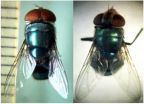(Press-News.org) VIDEO:
This image depicts Chrysomya megacephala larvae on decomposing fish.
Click here for more information.
Non-biting blow fly Chrysomya megacephala is commonly found in dead bodies and is used in forensic investigations to determine the time of death, referred to as the post mortem interval. A report of synanthropic derived form of C. megacephala from Tamil Nadu is provided for the first time based on morphological features and molecular characterization through generation of DNA barcoding. This study, significant in forensic investigations was published in the open access Biodiversity Data Journal.
Chrysomya megacephala is commonly found in corpse in many parts of the world. It is a tremendously abundant species and is used as fish bait in northern and south-west India. It is known to breed in human faeces, decomposed meat and fish as well as in discarded organic materials.
This dipteran fly, therefore, serves as a potential vector of many diseases due to its close association with human dwellings. In general, C. megacephala is considered important in medical, veterinary and forensic sciences. Post mortem interval (PMI) determination is useful in cases of homicide, suicide and accidental or unattended death because of natural causes. An important aspect of calculating the PMI is the accurate and quick identification of the dipteran fly collected from a crime scene.
Behaviour and developmental times of dipteran flies are essential in determining the PMI. Currently, the most common way is to identify dipteran flies for examining the adult stage under a compound microscope. It requires that the larvae collected from a crime scene should be reared until development is complete. The dipteran fly can be identified in the larval form, but if the critical characteristics are small or vary ever so slightly, misidentification is possible.
Morphological identification is difficult within the dipteran flies. A more precise method is to identify the dipteran flies genetically by encoding the collected DNA sequence at mitochondrial cytochrome oxidase gene subunit I (mtCOI). Presently, three forms of C. megacephala are recognized, namely, the normal form (nf), the synanthropic derived form (sdf) and the recently reported feral derived form (fdf).
The normal form is confined to forests of South Pacific Islands while synanthropic derived form has spread around the world from Papua New Guinea. The recently reported feral derived form (fdf) in the forests of the Himalaya, India is morphologically intermediate between normal and synanthropic derived forms. However, the occurrence of the synanthropic derived form of C. megacephala has not been documented in the State of Tamil Nadu, India.
In this context, a report for the first time for C. megacephala (sdf) from Royapuram fishing harbour, Chennai, Tamil Nadu, South East India is significant. A colony of C. megacephala was established from numerous second and third instar larvae collected from decaying fishes. The life expectancy of this fly is 40-45 days. Freshly emerged adults from pupae were identified through morphological and molecular studies.
INFORMATION:
Original Source
Ramaraj P, Selvakumar C, Ganesh A, Janarthanan S (2014) Report on the occurrence of synanthropic derived form of Chrysomya megacephala (Diptera: Calliphoridae) from Royapuram fishing harbour, Chennai, Tamil Nadu, India. Biodiversity Data Journal 2: e1111. doi: 10.3897/BDJ.2.e1111
Dead-body-feeding larvae useful in forensic investigations
2014-07-24
ELSE PRESS RELEASES FROM THIS DATE:
Nearly 50 years of lemur data now available online
2014-07-24
VIDEO:
Duke Lemur Center had made 48 years of primate data available online.
Click here for more information.
DURHAM, N.C. -- A 48-year archive of life history data for the world's largest and most diverse collection of endangered primates is now digital and available online. The Duke Lemur Center database allows visitors to view and download data for more than 3600 animals representing 27 species of lemurs, lorises and galagos -- distant primate cousins who predate monkeys ...
New mass map of a distant galaxy cluster is the most precise yet
2014-07-24
Astronomers using the NASA/ESA Hubble Space Telescope have mapped the mass within a galaxy cluster more precisely than ever before. Created using observations from Hubble's Frontier Fields observing programme, the map shows the amount and distribution of mass within MCS J0416.1-2403, a massive galaxy cluster found to be 160 trillion times the mass of the Sun. The detail in this mass map was made possible thanks to the unprecedented depth of data provided by new Hubble observations, and the cosmic phenomenon known as strong gravitational lensing.
Measuring the amount and ...
University of Delaware researcher describes new approach for creating organic zeolites
2014-07-24
Yushan Yan, Distinguished Professor of Engineering at the University of Delaware, is known worldwide for using nanomaterials to solve problems in energy engineering, environmental sustainability and electronics.
His early academic work focused on zeolites, porous rock with a well-defined, crystalline structure. At the atomic scale, their pore size is so precisely decided that zeolites can separate molecules with size differences of merely a fraction of an angstrom (one-tenth of a nanometer), making them useful to the chemical and petroleum industries as molecular sieves ...
Background TV can be bad for kids
2014-07-24
Parents, turn off the television when your children are with you. And when you do let them watch, make sure the programs stimulate their interest in learning.
That's the advice arising from University of Iowa researchers who examined the impact of television and parenting on children's social and emotional development. The researchers found that background television—when the TV is on in a room where a child is doing something other than watching—can divert a child's attention from play and learning. It also found that non-educational programs can negatively affect children's ...
Wireless home automation systems reveal more than you would think about user behavior
2014-07-24
This news release is available in German.
Home automation systems that control domestic lighting, heating, window blinds or door locks offer opportunities for third parties to intrude on the privacy of the inhabitants and gain considerable insight into their behavioral patterns. This is the conclusion reached by IT security expert Christoph Sorge and his research team at Saarland University. Even data transmitted from encrypted systems can provide information useful to potential burglars. Professor Sorge, who holds the juris Professorship in Legal Informatics ...
Natural products from plants protect skin during cancer radiotherapy
2014-07-24
Radiotherapy for cancer involves exposing the patient or their tumor more directly to ionizing radiation, such as gamma rays or X-rays. The radiation damages the cancer cells irreparably. Unfortunately, such radiation is also harmful to healthy tissue, particularly the skin over the site of the tumor, which is then at risk of hair loss, dermatological problems and even skin cancer. As such finding ways to protect the overlying skin are keenly sought.
Writing in the International Journal of Low Radiation, Faruck Lukmanul Hakkim of the University of Nizwa, Oman and Nagasaki ...
Identified a key molecule in flies that adjusts energy use under starvation conditions
2014-07-24
Most scientific literature devoted to the protein p53 refers to cancer biology, and the functions of this molecule as a tumour suppressor have been described in detail. Furthermore, also in cancer biology, it is known that p53 inhibits the metabolic pathways of tumour cells in order to block their metabolism and prevent their rapid growth and proliferation.
The most innovative research on p53 attempts to unveil its functions in the management of energy stores and nutrients in healthy cells. Recent studies with cell cultures have demonstrated that p53 is activated in response ...
Metastatic brain tumor treatment could be on the horizon with use of SapC-DOPS
2014-07-24
CINCINNATI -- Over half of patients being seen in the clinic for a diagnosed brain tumor have metastatic cancer, which has no treatment and detrimental outcomes in most cases.
However, a Cincinnati Cancer Center (CCC) study, published in the advance online edition of the journal Oncotarget, provides hope that previously studied SapC-DOPS could be used for treatment of brain cancer that has spread.
Xiaoyang Qi, PhD, member of the CCC, associate director and associate professor in the division of hematology oncology at the University of Cincinnati (UC) College of Medicine ...
Seeing the same GP at every visit will reduce emergency department attendance
2014-07-24
Attendances at emergency departments can be reduced by enabling patients to see the same GP every time they visit their doctor's surgery. This is just one of several recommendations made in a report published today, led by researchers at the University of Bristol.
Called 'Primary care factors and unscheduled secondary care: a series of systematic reviews', the report has been compiled by researchers from the University's Centre for Academic Primary Care who looked at evidence from studies around the world. They found that patients who saw the same GP every time they attended ...
New research: When it hurts to think we were made for each other
2014-07-24
Toronto - Aristotle said, "Love is composed of a single soul inhabiting two bodies." Poetic as it is, thinking that you and your partner were made in heaven for each other can hurt your relationship, says a new study.
Psychologists observe that people talk and think about love in apparently limitless ways but underlying such diversity are some common themes that frame how we think about relationships. For example, one popular frame considers love as perfect unity ("made for each other," "she's my other half"); in another frame, love is a journey ("look how far we've ...









